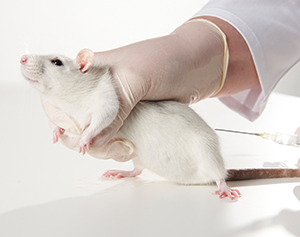Controversial Botox poisoning tests obscured
The HPRA’s publication of Ireland’s 2015 animal testing figures reveals that the Government continues to breach European Union legislation on their format. [1] The Irish Anti-Vivisection Society (IAVS) has discovered that the Government has failed to implement new rules passed in 2012 that were intended to inform the public and help coordinate efforts to develop new non-animal alternative tests.
The most critical omissions surround the failure to report on the purpose of animal toxicity tests, where chemicals are force-fed to or injected into animals. [2] This is particularly relevant in Ireland as toxicity tests accounted for 65% of all animal experiments in 2015. As a result, the public are being kept in the dark about whether animal tests are being done for medical purposes or for more controversial aims such as for the sake of marketing new pesticides or industrial chemicals. (The IAVS has previously persuaded the Government to correct these figures after pointing out that non-medical tests were incorrectly categorised as for medical purposes [3] ). In particular, the missing data has obscured controversial licences granted to conduct poisoning experiments to test botox-type products. [4]
The HPRA does mention in their commentary on the statistics that 99.6% of ‘Toxicity and pharmacology testing’ were mice subjected to ‘acute and subacute toxicity testing’. They appear to be collecting the required statistics but not presenting them comprehensively or clearly.
IAVS chairperson Yvonne Smalley comments:
‘We sincerely hope that the HPRA’s breaches of European law are due to an oversight rather than a deliberate attempt to withhold information from the public. But even on the more optimistic interpretation, it suggests a lack of official rigour and attention to this critical issue. Despite the potential of non-animal alternatives, the government has continued to licence the most harrowing poisoning tests for botox-type products, even when they are intended for mere cosmetic use. This dodgy practice breaks the spirit of long-standing laws banning animal testing for cosmetics, just for the sake of short-term profiteering. These tests are highly unpopular and borderline illegal – we need accountability to reassure the public that this problem is being dealt with as a matter of urgency.’
-ends-
Notes:
[1] Commission Implementing Decision 2012/707/EU. http://eur-lex.europa.eu/legal-content/EN/TXT/PDF/?uri=CELEX:02012D0707-20140115&from=EN
[2] Our comparison of the Irish statistics with EU requirements reveals that the Irish government is failing to provide the following tables required by EU legislation: numbers of animals re-used in more than one experiment, animals used to create new types of GM animals, the legal reason for toxicity tests, the type of substance tested or produced using animals, the use of animals to test batches of chemicals, the types of toxicity test including whether they involve lethal methods.
[3] http://www.irishantivivisection.org/government-false-figures.html
[4] http://www.irishtimes.com/news/science/inside-the-mouse-house-animal-testing-in-irish-labs-1.1562866 and http://www.irishexaminer.com/ireland/232000-animals-used-in-irish-lab-experiments-in-2012-260631.html


